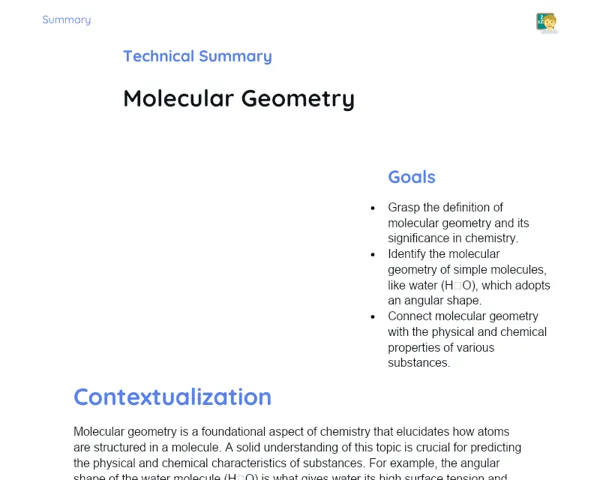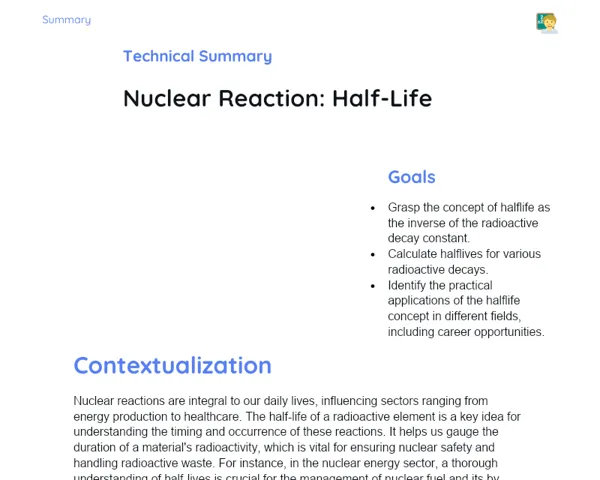Socioemotional Summary Conclusion
Goals
1. Describe the main phase changes: sublimation, condensation, vaporization, melting, and solidification.
2. Relate phase changes to observable phenomena in everyday life, helping learners recognize these transformations in their daily experiences.
Contextualization
Have you ever wondered why ice melts on a scorching summer day or how, during the winter, you can see your breath in the chilly air? 🤔 These are all examples of phase changes—phenomena that make our world so dynamic and intriguing! 🌍 Today, we will explore the fascinating processes of melting, solidification, vaporization, condensation, and sublimation, and understand how these transformations affect our daily lives and the environment around us. 🌱✨
Exercising Your Knowledge
Melting
Melting is the process in which a substance changes from solid to liquid. This transformation happens when the substance reaches a specific temperature known as the melting point. For instance, ice melts into water when subjected to temperatures above 0°C. This process is vital for life on Earth, playing a key role in the water cycle and the behavior of different materials.
-
Beginning of the Transformation: Melting starts when the substance reaches its melting point, the temperature at which the attraction between particles in the solid phase breaks, allowing them to enter the liquid state.
-
Everyday Importance: Knowing about melting helps us anticipate and manage processes like ice melting in our food and the shaping of materials used in industries.
-
Environmental Impact: Understanding melting is crucial for tackling environmental issues like glacier melting and its consequences on rising sea levels.
Solidification
Solidification is the process that reverses melting, where a substance transitions from liquid to solid. This occurs when the liquid cools down to a certain temperature below which the particles arrange themselves into a rigid crystalline form. A common example is when liquid water turns into ice at temperatures below 0°C.
-
Formation of Structures: During solidification, the substance develops an organized crystalline structure, which is essential for forming solid materials with specific characteristics.
-
Industrial Use: This process is crucial in various industries, ranging from freezing foods to manufacturing metals and plastics.
-
Environmental Relevance: Solidification significantly affects both aquatic and terrestrial ecosystems, influencing factors like ice formation in water bodies and the growth of mineral crystals in soil.
Vaporization
Vaporization is the process where a substance transforms from liquid to gas. This can occur in two ways: evaporation, which takes place at the surface of the liquid regardless of the temperature, and boiling, which happens when the substance reaches its boiling point. A typical example is the boiling of water to produce steam.
-
Evaporation vs. Boiling: Evaporation occurs gradually at the liquid's surface, while boiling is a rapid process that happens throughout the liquid when it hits a specific temperature.
-
Everyday Application: Vaporization is fundamental in activities like drying clothes, cooking, and regulating body temperature through sweating.
-
Climate Impact: Vaporization is a key part of the water cycle, affecting climate patterns and the distribution of rainfall across the globe.
Condensation
Condensation is the process through which a substance changes from gas to liquid. This occurs when vapor cools and its particles lose energy, clustering together to form a liquid. An example can be seen when water vapor condenses on a cold glass, forming droplets.
-
Energy Reduction: During condensation, gas particles lose thermal energy and come together to create a liquid, releasing warmth into the surrounding environment.
-
Practical Relevance: Condensation plays a key role in various technological processes, including liquid distillation and the functioning of refrigerators and air conditioners.
-
Natural Phenomena: In nature, condensation leads to cloud formation, fog, and dew—processes that are essential to the water cycle.
Sublimation
Sublimation is the process where a substance shifts directly from solid to gas without going through the liquid state. A well-known example is dry ice, which is solid carbon dioxide that sublimates into gas as it comes to room temperature.
-
Direct Transformation: In sublimation, the particles in the solid gain sufficient energy to move freely as gas without first becoming liquid.
-
Applications and Uses: This process is used in various techniques such as sublimation printing, food preservation, and in fire extinguishers containing carbon dioxide.
-
Safety Aspects: Understanding sublimation is important for the safe handling of substances that sublimate, preventing exposure to harmful gases or freezer burns.
Key Terms
-
Melting: Transformation from solid to liquid.
-
Solidification: Transformation from liquid to solid.
-
Vaporization: Transformation from liquid to gas.
-
Condensation: Transformation from gas to liquid.
-
Sublimation: Transformation from solid to gas without passing through liquid.
For Reflection
-
How can the phase changes we've explored today help us make more thoughtful choices regarding environmental conservation?
-
In what ways can understanding phase change processes influence our daily habits, such as energy conservation?
-
How can we apply the concepts of melting, solidification, vaporization, condensation, and sublimation to address practical issues in our daily lives and communities?
Important Conclusions
-
We learned about phase change processes: melting, solidification, vaporization, condensation, and sublimation.
-
We observed that these processes are essential to both natural and industrial phenomena, significantly impacting our everyday lives, such as the formation of ice and steam.
-
We recognized the importance of linking these concepts to environmental challenges and daily practices for a more sustainable use of resources.
Impacts on Society
Understanding phase changes has a profound effect on our society, especially in areas like environmental conservation and engineering. For instance, knowledge about melting and solidification is crucial for controlling energy production and minimizing waste of natural resources. Additionally, grasping the processes of vaporization and condensation is vital for developing climate control technologies and managing water resources more effectively.
On a personal level, knowing how sublimation and condensation work can guide us in making more responsible choices in our daily routines, from saving energy while using appliances to effectively preserving food. By connecting these transformations with our everyday activities, we can appreciate the practical value of scientific understanding and the importance of being more aware and informed citizens.
Dealing with Emotions
To help you manage your emotions while studying this topic, I suggest an exercise using the RULER method. First, try to recognize the emotions you experienced during the lesson, such as curiosity or frustration. Next, understand these feelings by reflecting on what triggered them. Accurately name these emotions and express how they impacted your learning. Finally, seek effective ways to regulate these emotions, for example, through breathing exercises or discussing your inquiries with classmates and teachers. This activity can help you become more aware of your feelings and employ strategies for maintaining focus on your studies.
Study Tips
-
Review your class notes and try explaining the phase change processes to a colleague or family member. This reinforces your understanding and highlights any gaps in your knowledge.
-
Watch educational videos and conduct simple experiments at home to visualize phase changes and enhance your grasp of the concepts.
-
Practice meditation or deep breathing exercises before studying to improve concentration and reduce anxiety, helping you stay grounded and motivated.


